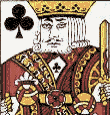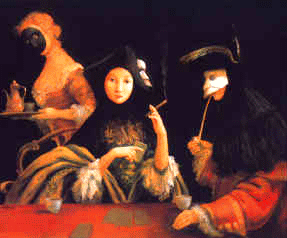 |
Progress Publishing Co. |
 |
|
Baccarat History |
 |
Progress Publishing Co. |
 |
|
Baccarat History |

![]()

![]()
Baccarat History
*******************************************************************
The Origins of Baccarat
A History of Baccarat Chemin-de-Fer and Baccarat-en-Banque
A History of American Las Vegas Style Baccarat (Punto-Banco)
*******************************************************************
The Origins of Baccarat
“Baccarat” is the French word for the Italian word “Baccara”, which means “zero” or “nothing”. On the basis of that obvious etymological connection the gambling authorities came to conclusion that the origin of Baccarat is the Italian game of Baccara. Supposedly, the game was devised by the Italian gambler Felix Falguirein at the end of the 15th century. Initially, the game was played with Tarot cards. It was brought to France by the soldiers of Charles VIII. The King Charles VIII of France (1470-1498) started Franco-Italian war in 1494 to seize the Kingdom of Naples.
|
|
|
The soldiers of King Charles VIII brought Baccara to France from Italy |
There is also an opinion due to the structural similarity that Baccarat evolved from the early versions of Blackjack at the beginning of the 19th century in France during the reign of Louis Philippe (1793 – 1850). There are many points of resemblance to Blackjack, but because of the smaller number of the player options, the money changes hands at Baccarat more rapidly and the element of Luck is much more present.
|
|
|
During the reign of Louis Philippe Baccarat acquired its modern form |
Some game historians trying to trace the origin of the game go all the way back in time and connect the beginning of Baccarat history with specific religious rituals of the Etruscan civilization (1500 B.C.) The purpose of those rituals was to choose a right candidate for the position of a female priestess. The priestess was chosen according to the result of the throw of a nine-sided die. If the result was 9 or 8 – the number equal or close to the number of the worshipped gods – the female candidate was approved. The numbers 6 and 7 meant a simple refusal and the lower numbers could lead to the death of a young girl.
A History of Baccarat Chemin-de-Fer and Baccarat-En-Banque
While it is possible to argue about the true origins of Baccarat, its structural development and how long Baccarat history really is, there is no doubt that the French gave the game its modern form and characteristics. The game was very popular among the French nobility in the 16th and 17th centuries when it was played in private houses and at the royal courts. During Napoleon rule Baccarat was played in many illegal gambling clubs.
|
|
|
In Napoleon years Baccarat was very popular in illegal gambling clubs in Paris |
In the early 1900s Baccarat was the most popular game in the casinos of the French Riviera. At that time the two versions of Baccarat existed: Chemin-de-Fer (railroad in French) and Baccarat-en-Banque. The main difference between them was in who dealt the game and, also, in the number of the active players. In Baccarat Chemin-de-Fer a player with a highest bet dealt the shoe and banked the game - he was the banker. Another player with the highest bet represented the rest of the players against the banker. In Baccarat-en-Banque the house held the bank and the dealer dealt the cards to the players. Also, the table had a double-table design to seat 5 players on the left and the right sides of the banker. Two players - one on the left and one on the right sides - represented all the players on their respective sides against the banker. The drawing and standing rules and player's options were the same in both versions of the game.
A History of American Las Vegas Style Baccarat (Punto-Banco)
Baccarat history in the United States started around 1911-1912 when it was introduced in the few illegal casinos in the state of New York. The game disappeared after a couple of years being completely overshadowed by a structurally similar but a lot more popular Blackjack. Baccarat made its second American debut in Las Vegas in 1958-59 when the executives from Star Dust and Sands reintroduced the game. This time around the game stayed and enjoyed the growing popularity it really deserved. In American casinos the American Las Vegas Style Baccarat is played. In foreign countries this version is also called Punto-Banco. The rules of American Baccarat left no options for a player. All decisions about drawing or standing are determined by the rules only, the game goes completely on auto-pilot and the players are simply informed by the dealer if they have won or lost. Tommy Renzoni (“Renzoni on Baccarat” 1974) claims that he was the one who brought Baccarat in 1959 to Vegas from Cuba. He was running a Baccarat table at movie star George Raft’s Capri Casino in Havana when Castro overthrew the Batista government. Renzoni moved to Vegas to work as a casino executive in Sands Hotel where he was present on the opening night of Baccarat, when the house was alleged to have lost $250,000. The rules of American Baccarat were the same as in the game conducted by Renzoni in Cuba.
Presently, in addition to American style Baccarat, Mini-Baccarat can be found in all American casinos. The rules of Mini-Baccarat are identical to American Baccarat. The only difference is that the dealer, not the players, always deals the cards. The game is conducted on a small black-jack size table. Like in American Baccarat, a player in Mini-Baccarat has no drawing or standing options and the only thing he can do besides betting is to cut the cards when offered.
Copyright Progress Publishing Co. 2006
Selected References:
| John Scarne New Complete Guide to Gambling | Leo Markun A History of Gambling |
| David G. Schwartz Roll the Bones/The History of Gambling | Alice Fleming Something for Nothing/A History of Gambling |
| Carl Sifakis The Encyclopedia of Gambling | David Parlett Card Games |